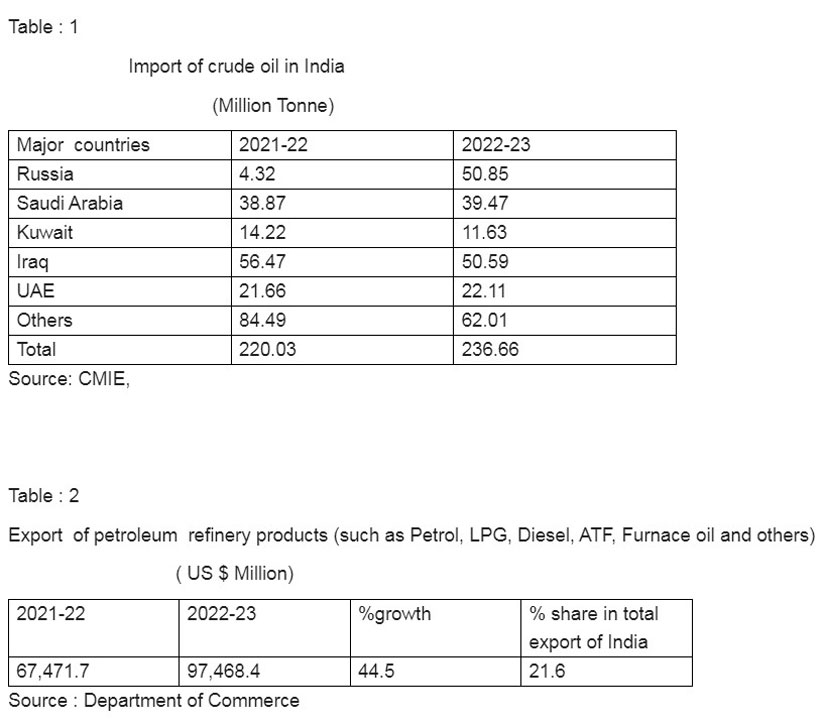How the Russian connection insulated India from oil shock and brought economic stability
The revival of trade relations with old friend Russia is the turning point in India’s oil dependency on the Arab world. This has strengthened India’s resilience to oil shock to a considerable extent.

Russia, which had become a negligible trade partner of India in recent times, has once again re-emerged as a pivotal economic partner. In 2022-23, Russia was the fifth largest trading partner of India, compared to 25th in 1997-98. This new phase of Russian partnership has resulted in cushioning India from the oil shock that was the outcome of global sanctions on Russia which buffeted the EU economies . Hitherto, India had been vulnerable to Arab-led oil shocks that severely impacted its economy. But this time it was a boon to India as it not only shielded it from the oil shock, but also rejigged its exports.
In 2022-23, Russia became the largest oil supplier to India. Nearly 22 percent of total crude oil was imported from Russia, compared to 1.9 percent in 2021-22. Russian oil became the biggest base for India’s manufacturing of oil refinery products and exports. India imports crude oil, refines them domestically and exports petrol, diesel, ATF (automatic transmission fluid) and others.
Petroleum refinery products have been the major products in the Indian export basket. Since Russia was the biggest supplier of crude oil in 2022-23, it played a key role in boosting export of petroleum refinery products and these became the engine for India’s overall export growth.
Export of petroleum refinery products spurred by 44.5 percent in 2022-23 y-o-y basis. Its share in total exports of the country increased to 22.6 percent in 2022-23 , from 15.9 percent in 2021-22 . All other major export items exhibited a normal growth of between 8 to 10 percent.
Unique trade balancing
These demonstrate India’s unique balancing of imports of crude oil by export of petroleum refinery products. India imports over 90 percent of its oil requirement. This smart move led to lesser pressure on BOP ( Balance of Payment). In 2022-23, India imported crude oil worth US$ 157,531 million. It exported petroleum refinery products worth $ 97,468 million , leaving a balance of US $ 60,063 million as the net imports
In the preceding year 2021-22, when Russia had negligible share in crude oil imports, net imports were much higher at USD 76,237 million, casting more pressure on BOP.
Average basket price of oil imported from Russia was far cheaper than Arab oil from traditional suppliers like Saudi Arabia, Kuwait, Iraq and the UAE. During April-August 2023-24, while the average price of Arab oil was ranging between USD 75.9 to 89.7 per barrel, the average price of Russian oil was USD 68.9 per barrel.

The EU prohibited maritime exports of Russian oil and levied a price cap of USD 60 per barrel in December 2022. These followed USA, G-7 and Australia price capping on Russian oil. An angry Russia retaliated and banned the export of oil to these nations from February 1, 2023/
Overrides sanctions
To tide over the Western sanctions, India and Russia set up alternative arrangements. Indian refineries accepted Russian insurance. Russian oil suppliers are trying to handle Ural oil transport to India by using their own shipping. Further, the Indian government has permitted nine Indian banks to open vostro accounts with Russian banks Gazprombank and VTB. This helped to have a swapping deal with Russian oil in rupee currency.
Russian crude, converted into refinery products and exported from India, does not violate internationally recognized Rules of Origin. It has been defined that crude, once refined in another country, is classified for the purpose of trade as originating from the refinery country. Thus, notwithstanding a ban on import of Russian crude oil under global sanctions, Russian crude was flowing through India in the
form of refinery products like petrol, diesel, jet fuels and others. India and China, who are not part of sanctions, were able to legally import Russian crude and refine them into oil products, according to the Centre for Research on Energy and Clean Air (CERA).
Besides trade, Russian intervention shielded India from upsurge in retail inflation. Generally, inflation is the first shock of an oil price hike. As and when oil price spikes, inflation increases. This time inflation recorded normal growth even after sanction.
The revival of trade relations with old friend Russia is the turning point in India’s oil dependency on the Arab world. This has strengthened India’s resilience to oil shock to a considerable extent. Repeated OPEC threats for cuts in production and trigger a surge in oil prices increased oil vulnerability, which used to act as a headwind hampering the growth of the Indian economy. With the oil dependency shifting to Russia, there is a welcome return of oil stability in the Indian economy.
(The writer is an Indian trade consultant and analyst. Views are personal. He can be contacted at subratamajumder0604@gmail.com)














Post a Comment